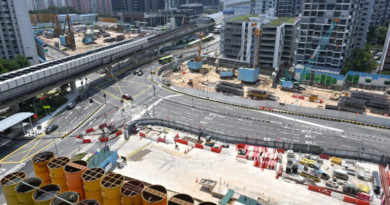Hydrogen trains and trucks are coming — for better or worse
When a sleek new train rolls into Southern California later this year, it will be the first in the nation and one of only a handful globally to be running on hydrogen.
The four-car commuter train is slated to arrive in San Bernardino County this summer after completing testing at a federal facility in Colorado. Its electric motors are powered by a combination of batteries and fuel cells, the latter of which convert hydrogen into electricity, emitting only water vapor as they do, not the toxic pollution that diesel engines spew.
More hydrogen trains are soon to follow. Last year, the California Department of Transportation, or Caltrans, signed an $80 million contract for four sets of longer-distance models that will link cities in the Central Valley starting in 2027. The Swiss company Stadler Rail, which has a manufacturing site in Salt Lake City, is making units for both projects.
“We think this is going to be one of the most promising technologies for typical [rail] corridors in California,” said Kyle Gradinger, assistant deputy director of rail transportation for Caltrans.
The fuel-cell trains will be hitting the rails at a pivotal yet contentious time for hydrogen-powered transportation in California and beyond.
The Golden State has worked for decades to curb harmful tailpipe emissions from diesel- and gasoline-burning engines in its smog-choked cities—a push that’s being replicated in more than a dozen states. California has set increasingly stringent policies and invested billions of dollars over time to both spur development and drive adoption of “zero-emission” technologies for cars, buses, trucks, rail and heavy-duty cargo equipment.
Today, the vast majority of zero-emission vehicles use only batteries. But the state’s tiny hydrogen-vehicle market recently received a giant jolt from the Biden administration.
Late last year, the U.S. Department of Energy awarded $1.2 billion to California to establish one of seven “clean hydrogen hubs” nationwide, through a program created by 2021’s Bipartisan Infrastructure Law. In California, much of the funding will be directed toward accelerating heavy-duty hydrogen trucks and building out the necessary refueling infrastructure. Hydrogen trains and buses are likewise expected to proliferate as clean H2 supplies become available.
“We’re entering a new era,” said Lewis Fulton of the University of California–Davis, who is chairing the transportation working group within California’s hydrogen hub.
The regional hubs are also intended to clean up hydrogen production itself, given that nearly all H2 today is made with fossil gas using energy-intensive methods. The lowest-carbon alternative is to make hydrogen using water and renewable electricity through electrolysis, a process that’s not yet happening on a commercial scale.
As H2-vehicle market grows, so do environmental concerns
Many questions still remain about whether hydrogen can, or should, play a prominent role in decarbonizing ground transportation, particularly where other viable technologies—including batteries for cars and direct electrification for trains—are available as alternatives.
For now, hydrogen’s role in the sector is fairly limited.
Only 15 heavy-duty fuel-cell trucks were deployed nationally as of June 2023, compared to more than 17,700 battery-electric trucks and cargo vans, according to the latest count by Calstart, a clean transportation group. Of the 5,500 zero-emission transit buses on the road in 2022, only about 210 buses—or 4 percent—used fuel cells instead of batteries, Calstart reported.
As for passenger vehicles, nearly 3,000 fuel-cell cars were sold in the United States in 2023. That pales in comparison to the record 1.2 million electric vehicles that Americans bought last year, representing 7.6 percent of the total U.S. vehicle market.
Still, the hydrogen-vehicle market is steadily expanding, buoyed by a raft of federal and state incentives, including a $276 million funding program for hydrogen infrastructure in California.
Vehicle-maker Nikola Corp. said it produced 42 hydrogen semi-trucks last year, which are expected to hit the road soon. Public transit agencies in California will likely order hundreds more hydrogen buses in the coming years as they work to meet state deadlines for achieving zero-emission operations. And, if all goes to plan with the first hydrogen trains, Caltrans could order up to 25 more train sets under its contract with Stadler Rail.
Critics of the state’s hydrogen-powered push have two key concerns.
First, energy analysts and environmentalists worry that huge tranches of taxpayer dollars will be wasted on advancing technology and infrastructure for applications with little to no need for hydrogen. Second, they’re concerned that using clean hydrogen in suboptimal ways will make it harder and more expensive for other industries to obtain much-needed H2 supplies.
“Hydrogen should be kept for the sectors for which there is really no alternative,” said James Dixon, an engineer and transportation lecturer at the University of Strathclyde in Scotland.
For instance, long-distance air travel and international shipping are both widely expected to rely on hydrogen-derived fuels to slash greenhouse gas emissions from their operations. No other viable solutions exist just yet for replacing fossil fuels in giant jets and ships.
That’s not the case for most ground vehicles. As batteries and battery-charging technology improve, electricity is becoming a far more cost-effective and reliable fuel source for not just consumer vehicles but also heavy-duty and long-haul trucks. When it comes to rail, electrification is widely recognized within the industry as the most efficient and sustainable way to power trains.
“Overhead wire needs to be the dominant thing,” said Brian Yanity, who leads advocacy efforts in Southern California for the Rail Passenger Association of California and Nevada. He sees hydrogen rail initiatives as a “greenwashing” tactic by oil and gas companies looking to secure new markets for fossil-derived hydrogen, and not a sustainable alternative to diesel locomotives.
Hydrogen can still play a niche role in transportation
Yet even hydrogen’s more skeptical observers acknowledge the technology might still be needed in certain situations where charging batteries or harnessing electricity remains too logistically or financially cumbersome. That could include trucking cargo over 500-mile stretches, using cargo-handling equipment around-the-clock, or running trains through remote and sparsely populated corridors.
Hydrogen vehicles can refuel relatively quickly since they fill up at H2 fuel stations much like gas- or diesel-guzzling cars at the pump. Large fuel-cell vehicles tend to weigh far less than their battery-powered counterparts, which helps extend the range that hydrogen trucks can travel before needing to stop for fuel.
“A lot of people would argue for having 100 percent battery-electric vehicles,” said Kelly Ratchinsky, who manages hydrogen infrastructure programs at Calstart. But she noted that “diversifying the energy mix,” including using hydrogen for long-haul trucking and goods movement, can complement the limitations of battery-powered transit.
As for rail, California’s fuel-cell trains will allow transit authorities to work around a major complication: Private companies own most of the railroads in the state and nationwide, and they’ve shown little interest in installing highly efficient yet expensive overhead wires or other electrical infrastructure that could directly power passenger and freight trains—a common practice in most of the world and one that dates back nearly 150 years.
“That’s why we’re working on a lot of different solutions” for curbing rail emissions, said Gradinger of Caltrans.
He said the state agency is collaborating closely with California’s hydrogen hub initiative to help establish H2 refueling infrastructure for trains by 2030 and to specifically secure supplies of clean hydrogen made from renewables. Until that happens, hydrogen trains in both San Bernardino County and the Central Valley will use mobile tanker trucks to refuel with conventional, dirty hydrogen.
“There’s zero tailpipe emissions, so the real [environmental] question becomes, what’s the source mix for creating that hydrogen?” Gradinger said. “We’re helping to push the needle to get the production and distribution to use the cleanest hydrogen that we can.”
Source: canarymedia.com




